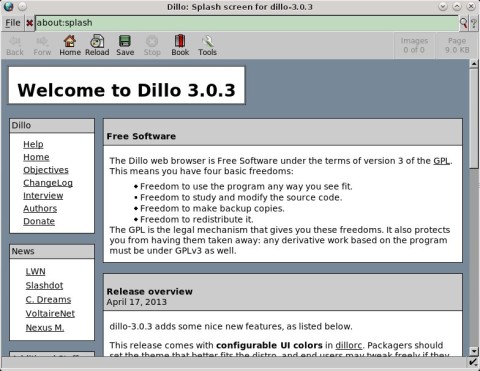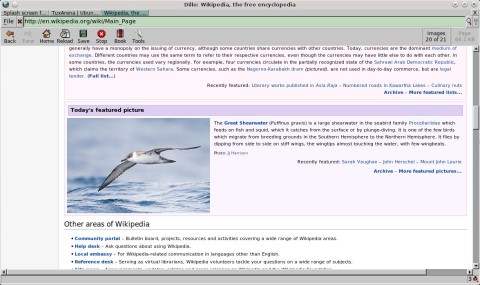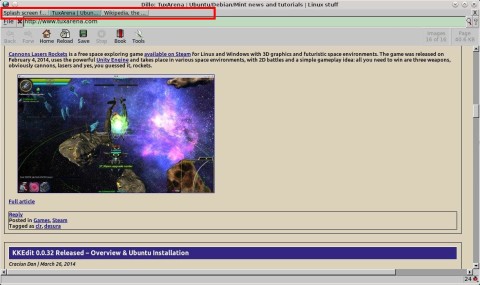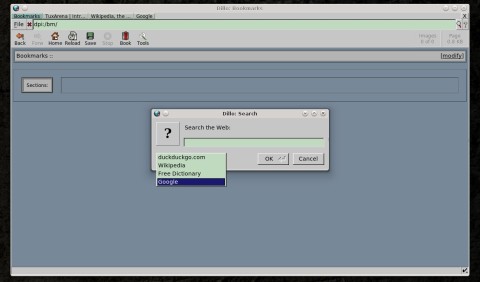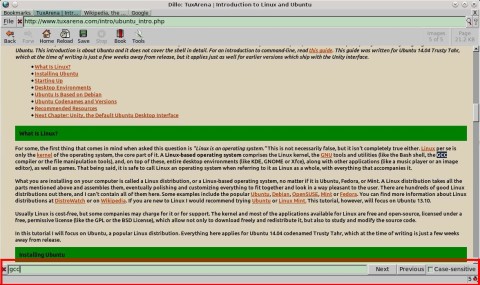I remember the first time I’ve encountered Dillo was when trying one of the older versions of Damn Small Linux, which at the time was pretty popular as a minimal distribution and came with this very small web browser.
Dillo is probably the most lightweight graphical web browser for Linux, thinking about something more stripped of advanced features only makes me look at terminal-based web browsers. Although I can’t say I’m using it much since I need the power of Firefox, I like Dillo very much because it serves very well its purpose, of being as simple as possible. The few features that it comes with may be just enough for some users.
Dillo is written in C++ and uses the FLTK (Fast Light Toolkit) for its interface. It keeps everything very simple, yet has support for some HTML/CSS features, including images, several HTML5 elements. Dillo also has support for multiple tabs, which were introduced in version 2.0, bookmarks, and options to enable or disable CSS or displaying images.
Support for images – there is an option to disable displaying images as well:
Dillo comes with multiple tabs support:
The interface is pretty simple and compact. There is a File menu to open local documents, URL, new windows or new tabs, as well as closing the current tab. It seems that the save the current HTML entry is located only in the taskbar, and not in the menu. Except for the menu, Dillo includes a location bar, a tabs bar, a search function, a toolbar and the status bar.
The search function comes with several search engines: duckduckgo.com, Wikipedia, Free Dictionary and Google.
There are four search services bundled by default in Dillo:
The toolbar has buttons to go back, forward, home, reload the current page, save the document, stop, open bookmarks and tools to enable/disable CSS or showing images. These minimal options are actually really great, since one may expect from such a browser to actually offer these features. Great work in my opinion for Dillo developers here. The toolbar also shows the size of the currently loaded page and images.
The status bar shows the web address of the link currently under the mouse cursor, as well as any HTML errors encountered in the document.
Dillo also includes a search function, which appears above the status bar when pressing Ctrl+F.
Among some drawbacks I was able to catch was the fact that Dillo doesn’t seem to auto-focus certain text boxes, for example the Google search box.
If you’re looking for a simple web browser, Dillo is definitely a go, so if you haven’t tried it yet, I strongly recommend it, since it’s a very fine piece, especially if your web browsing needs are satisfied by it.
Please share your thoughts in the comments below. Do you use Dillo on a regular basis, and if so, why and for what tasks?
Without support for Javascript (that’s why no autofocus) and CSS, most eb activity beceoms impossible. This should be in the first paragraph. Having said that Dillo is FAST and a commendable project
Dillo is really useful for scripting. I wouldn’t think of using it as a primary use browser, but it’s handy to have for other purposes.
I used Dillo quite alot for just looking things up online, because it loads instantly even on a pentium 3!
BTW, I’m posting this on DIllo running on a PIII.
Even with its limitations, Dillo is great on a Raspberry Pi Zero. On Raspbian “stretch” the Chromium browser on the Pi Zero is sloooowww. Dillo is installed by default, but it’s not displayed in the LXDE menu.
I’m using Dillo with the Devuan Rasberry PI 3 B+ OS. I find that firefox is simply too big to load with the XFCE desktop running. And most of the websites I visit are flat websites rather than Java enabled websites. I wish they had a palemoon for this OS but, maybe someday they will support javascript in Dillo and help us out with some of these issues. I can also close tabs by pushing the wheel button in the middle of my logtech mouse.
Anyway, it’s very light and fast and can bookmark all my flat sites I visit.




